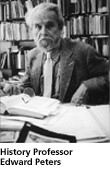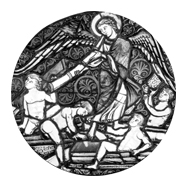

Apocalypse When?
Reading the Signs of the Times in Y1K
One of the first things you notice walking into History Professor Edward Peters’ book-encased office is a phantasmagorical painting by sixteenth century Flemish artist Pieter Bruegel. "Dulle Griet" or "Mad Meg" is a nightmare landscape of tormented grotesqueries, part human and part beast, all swarming in a great war set against a flame-red sky. Amid the chaos, there’s an insect body attached to a man’s head and a fish crawling on awkward insect and human-like appendages. A misbegotten being with no abdomen stands on one booted leg and an arm that rests on the ground at the crook of the elbow. It holds a begging bowl in that hand. A human head hangs upside down between these limbs and from the mouth—set about where the anus might be—a spoon protrudes backward. The eyes of the unhappy creature are wide open, as if surprised to find itself so inexplicably and all at once transformed. Perhaps it was once human, but such categories no longer apply. And lest there be any doubt that the world has come wholly undone, there is Meg herself, the dominant image—an armor-clad female wielding a sword and leading a ravaging army of terrible looters before the gates of hell, depicted here as a gaping human mouth. Anything resembling what might be called natural law or quotidian expectation has been decisively overturned.
The poster suggests the existence of some implacable and overarching realm poised to break upon the world. Those who lived ten centuries ago would have called it the supernatural order or perhaps the wrath of God. "At the turn of the second millennium," says Peters, "the people of western Europe did not face the technological problems that we do at the turn of the third. But they did have another kind of problem that is still unsolved at the end of the twentieth century."
Peters is teaching a class this fall on The Year 1000 and the End of the World. The course looks at what he sometimes refers to in sardonic moments as "the Y1K problem": the Second Coming of Christ. He doesn’t mean to sound disrespectful. The rigidly stratified, largely third-world agricultural society that lived in western Europe at the end of the first millennium looked out on a world whose ordo was the manifestation of God’s design. "This was a Christian society not simply in its religious profession but in the shape of its whole culture," he explains. "It’s hard for us to imagine this. Living in a culture in which a particular vision of Christianity was woven through every aspect of life, they wondered whether or not Y1K had anything to do with the scenario of the last days and the end of time."

Peters talks rapidly as though his tongue were rushing to keep pace with runaway thinking processes. A gold chain drapes from the lapel to the breast pocket of his tweed jacket. With a gray beard and wavy, swept-back hair, he has the craggy air of a mellowed and manicured prophet who long ago exchanged caves and wild locusts for a cocoon of manuscripts and careful scholarship. His erudition ranges over the intellectual history of Europe from about the second to the seventeenth centuries. The Henry Charles Lea Professor of History, Peters affirms great respect for the virtues millennial anxieties fostered in those who lived in the waning days of the eleventh century.
The happenings that foretell the coming of the world’s end—what Peters calls "the scenario"—are laid out in Christian scripture, mostly in the Book of Daniel, the Gospel of Matthew, and the Book of Revelation. They tell in vivid, terrifying imagery of world-shattering events that will usher in the Second Coming and the Last Judgment. "Have you ever read Revelation?" he exclaims. "It’s a humdinger!" The basic scenario gets elaborated over time by the accrual, from noncanonical sources, of new elements such as the appearance of the Antichrist and the proliferation of heresies. Jewish and Roman texts have contributed to the forbidding vision of the end time. Between 700 and 800 AD the whole scenario is pretty much in place. "So by that time," he says, "anything that happens that seems to fit part of this very extensive and detailed scenario can be taken, maybe, as a sign of the end."
The end of history and the approaching judgment of the human race are central tenets of the Christian religion. In the face of that certainty, the only question can be: When? "But of that day and hour knoweth no man," Jesus cautioned (Matthew 24:36). "In the years between 979 and 1033," remarks Peters, "the Y1K problem was: Is it now?"
Calculating when the earth could be expected to shake beneath the headlong gallop of the Four Horsemen was a controversial and thorny problem. The learned knew that the calendar system determining the millennium’s date was wrong, but they were unsure of how far off it was. One chronologer contended that the thousandth year of Jesus’ birth had passed in 979. Some argued that the end would fall one thousand years after the crucifixion of Jesus. Others linked the redeemer’s birth and death, reckoning that he would return in judgment when Easter and the feast of the Annunciation fell on the same day, which occurred in 1064-65. Cloaking the day of the apocalypse in mystery had great advantages: it allowed prognosticators to concede the weakness of the human intellect and recrunch the numbers whenever their forecasts failed. The "certainty" that the scenario would inevitably be fulfilled is never dismissed; just the when changes.
The learned were repeatedly and urgently asked by church officials and kings to interpret disturbing events: drought, flood, plague, heresy, and the decline in belief—or the advent of renewal. A wave of brutal invasions struck western Europe between 850 and 950, notes Peters, disrupting the political, social, and economic order. Were these the signs foretelling the approach of the last days? The influential church father Augustine, who lived at the turn of the fifth century, taught that signs laid out in the Book of Revelation were to be understood allegorically. Jerome, another church patriarch, quipped that Revelation "has as many mysteries as it does words."
Still, the meanings of historical events in the eleventh century were often cast in terms of the scenario for the end of time. "The waves of evil are breaking ever higher," wrote Abbot Odo, leader of monastic renewal at Cluny. "Dangerous times are upon us; the world is threatened with its end." Each appearance of an apocalyptic sign reminded people of the expected end of the world, especially as the millennium of Christ’s birth drew near. "To many around the year 1000," Peters comments, "things looked about as bad as they could get, and some of them looked indeed like the scenario of the last days."
 In
popular parlance, the word"apocalypse" denotes a world-ending cataclysm.
The term comes from the Greek apokalypsis, which means "the lifting
of a veil." In the Christian religion, the end of time is the moment of
final and complete revelation when "a new heaven and a new earth" will
be ushered in. The urgent questioning inspired by millennial expectations
helped awaken a call to penance, good works, and prayer as the eleventh
century came to a close. Pastors preached about the coming terrors leading
up to the day of judgment and urged repentance and greater piety upon
the population. "We have arrived at the last day of the whole epoch,"
proclaimed Abbott Odo. "If, therefore, the last hour has arrived, of what
use are the fruits of obsessive desire, which as soon as it ends leaves
no sign that it ever existed at all?" The abbott’s rhetorical query
points up the impermanence of temporal things in the face of eternity,
which would unfold as everlasting bliss or torment, depending on the pronouncements
of the world’s judge.
In
popular parlance, the word"apocalypse" denotes a world-ending cataclysm.
The term comes from the Greek apokalypsis, which means "the lifting
of a veil." In the Christian religion, the end of time is the moment of
final and complete revelation when "a new heaven and a new earth" will
be ushered in. The urgent questioning inspired by millennial expectations
helped awaken a call to penance, good works, and prayer as the eleventh
century came to a close. Pastors preached about the coming terrors leading
up to the day of judgment and urged repentance and greater piety upon
the population. "We have arrived at the last day of the whole epoch,"
proclaimed Abbott Odo. "If, therefore, the last hour has arrived, of what
use are the fruits of obsessive desire, which as soon as it ends leaves
no sign that it ever existed at all?" The abbott’s rhetorical query
points up the impermanence of temporal things in the face of eternity,
which would unfold as everlasting bliss or torment, depending on the pronouncements
of the world’s judge.
Mere anxiety is too narrow a focus to capture the significance of apocalyptic feelings that bubbled up as the first millennium’s end approached, says Peters. "It may also have inspired a heightened sensitivity to moral demands and a resolve to change for the better before it was too late—never a bad idea."
The passing of the year 1000 did not change the scenario, neither did the passing of later apocalyptic years such as 1033, when a great famine swept across Europe, and 1099, when Jerusalem was captured by the army of the First Crusade.
Aelfric of Eynsham, an Anglo-Saxon author, wrote in his Catholic Homilies at the end of the first millennium, "Often people claim, ‘Now the day of judgment is at hand,’ because the signs that will announce it are fulfilled. But then war follows war, calamity follows calamity, earthquake follows earthquake, one people attacks another, and the Bridegroom still does not come.... How do we know when He will come? Even as He Himself has said: ‘At midnight.’ But does not ‘At midnight’ mean nothing more than that you don’t know and that you do not expect it? Then He will come."
Notes Peters: "Year after year they needed only to discard particular interpretations of the scenario, never the scenario itself, as one or another designated year passed and the world did not end. In their sense, we still live in the shadow of Y1K."